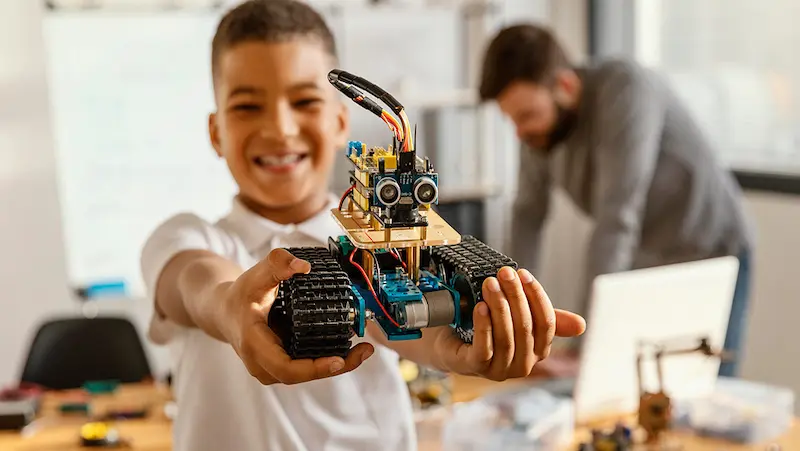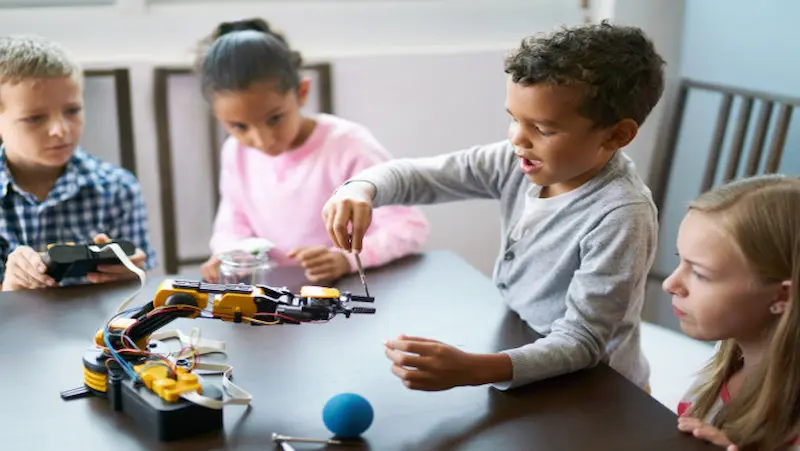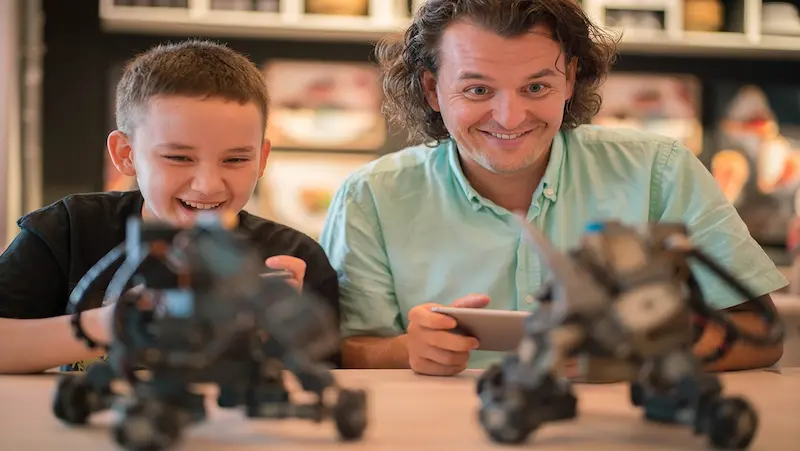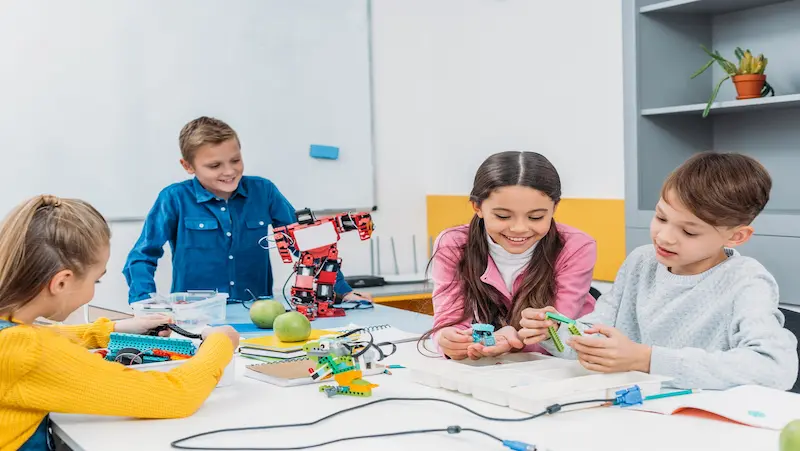In recent years, the burgeoning influence of robotics has woven its way into the lives of children, ushering in a new era of learning and exploration. As technology evolves, so too does its impact on the young minds of today, as robotics opens doors to creativity, problem-solving, and an exciting journey into the world of innovation. This introduction delves into the rising significance of kids and robotics in children’s lives, highlighting the transformative role it plays in shaping young intellects and inspiring future generations.
Table of contents
Understanding the Basics of Robotics
Robotics, the fascinating blend of science and technology has come a long way since its inception. From automated factories to friendly companion bots, robots have seamlessly integrated into our lives, capturing our imaginations and shaping the future.

What Are Robots and Robotics?
At its core, robotics for kids is the field of study that revolves around designing, creating, and operating robots. But what exactly is a robot? Think of it as a versatile machine, programmed to perform tasks autonomously or under human guidance. These tasks can range from simple repetitive actions to complex problem-solving activities.
How Robotics Evolved Over the Years
The evolution of robotics has been nothing short of remarkable. The concept of automatons dates back to ancient times, with early inventors and philosophers envisioning mechanical creations that mimic human actions. The Industrial Revolution saw the emergence of mechanized devices, while the mid-20th century marked the birth of modern robotics with the advent of programmable machines.
Types of Robots Suitable for Kids
Introducing children to robotics classes for kids can be an exciting and educational journey. Several types of robots are designed to captivate young minds while promoting learning and creativity:
Educational Robots: These robots are specifically designed for learning purposes. They often come with user-friendly interfaces that allow kids to program the robots to perform various tasks. They provide hands-on experience in coding, problem-solving, and logical thinking.
Robotic Kits: Robotic kits enable kids to build their robots from scratch. These kits typically include components like sensors, motors, and controllers. Assembling the robot provides an interactive way for children to understand the mechanics behind robotics for kids online.
Companion Robots: These robots are designed to engage children in interactive and entertaining ways. They can respond to voice commands, tell stories, play games, and even teach basic skills.
Educational Significance of Robotics for Kids

Enhancing STEM Skills through Robotics
Robotics is a perfect platform for cultivating Science, Technology, Engineering, and Mathematics (STEM) skills in children. By engaging in hands-on robotic projects, kids are exposed to practical applications of scientific concepts. They learn to design, build, and program robots, fostering a deep understanding of physics, mechanics, and electronics.
Fostering Problem-Solving Abilities
Problem-solving is a skill that transcends disciplines and is crucial in every aspect of life. Online robotics for kids offers a unique environment for children to encounter real-world challenges and devise solutions. As kids tinker with robotics kits, they encounter obstacles that require critical thinking and creative solutions.
Encouraging Creativity and Imagination
Robotics is an artistic canvas where imagination knows no bounds. Kids have the freedom to conceptualize, design, and bring their robotic creations to life. This process encourages out-of-the-box thinking and nurtures creativity. As children personalize their robots, they blend artistic vision with technical skills, resulting in unique, one-of-a-kind creations.
Best Practices for Introducing Kids to Robotics

Age-Appropriate Robotics Activities
One size does not fit all when it comes to robotics courses for kids education. Tailor activities to the child’s age and developmental stage to maintain their interest and prevent frustration. For younger kids (ages 4-7), focus on simple, hands-on projects like building basic motorized robots using building blocks.
As children grow (ages 8-12), gradually introduce more complex tasks involving coding and problem-solving. Teenagers delve into advanced robotics projects for kids that challenge their technical skills and encourage innovation.
Creating a Safe and Supportive Learning Environment
Safety should always be a top priority when working with robotics materials. Ensure that the workspace is free from hazards and that kids wear appropriate protective gear when necessary. Supervision is key, especially for younger children, to prevent accidents and guide them through the learning process.
Selecting the Right Robotics Kits and Tools
Choosing suitable robotics kits for kids and tools is crucial for a successful learning journey. Opt for kits that align with the child’s skill level and interests. Basic kits with pre-designed parts and simple coding activities are great for beginners. More advanced kits offer opportunities for customization and creativity.
The Role of Parents in Supporting Kids’ Robotics Journey

Encouraging Curiosity and Exploration
Curiosity is the spark that ignites a child’s passion for learning. When it comes to robotics, it’s important for parents to foster this curiosity from an early age. Encourage your child to ask questions, experiment, and explore. Provide them with age-appropriate robotics kits or toys that engage their imagination and problem-solving skills.
Nurturing a Growth Mindset in Robotics
A growth mindset is a belief that abilities and intelligence can be developed through effort and perseverance. As parents, we can instill this mindset in our children by praising their efforts, strategies, and improvements rather than solely focusing on outcomes. When your child faces challenges in robotics, help them see these hurdles as opportunities to learn and grow.
Building Parent-Child Robotics Projects
One of the most effective ways to support your child’s robotics journey is by actively participating in it. Collaborating on robotics projects not only strengthens the parent-child bond but also provides valuable learning experiences. Start simple with joint activities like building a basic robot, designing a maze, or programming a simple task.
The Future of Kids and Robotics

Predictions for Robotics in the Coming Decade
The next decade promises an exciting tapestry of advancements in robotics that will deeply impact our society and, more importantly, our children’s lives. As technology continues to surge forward, several predictions emerge:
Education and Learning Revolution: Robotics will become a cornerstone of education, enabling interactive and personalized learning experiences.
Healthcare Support: The integration of robotics in healthcare will expand, enabling more accurate diagnoses and treatments. Robots will assist doctors, making medical procedures less intimidating for children and enhancing patient care.
Advancements in Kids’ Robotics Technologies
The realm of robotics tailored for kids is flourishing, sparking curiosity and creativity in young minds like never before. With each passing day, new frontiers are being explored:
Hands-On Learning Tools: Robotics kits designed for children will become increasingly sophisticated, allowing kids to build and program their robots.
Entertainment and Play: Interactive and customizable robot toys will captivate children’s imagination, encouraging them to explore STEM fields in an engaging and playful manner.
Exploring New Frontiers of Human-Robot Interaction
The interaction between humans and robots is evolving rapidly, and the implications for kids are profound:
Social Skills Development: Robots will assist in developing social skills by providing a safe environment for kids to practice communication, empathy, and teamwork.
Learning through Play: Interactive robots will create immersive learning experiences, fostering curiosity and exploration while making education enjoyable.
Conclusion
In conclusion, embracing a robotic future for kids holds immense potential to shape a generation equipped with essential skills for the 21st century. By fostering curiosity, problem-solving abilities, and technical aptitude from an early age, we empower children to navigate and contribute meaningfully to an increasingly automated world.
As long as we balance technological advancement with ethical considerations and holistic education, we can ensure that these young minds grow into responsible innovators who harness the power of robotics camps for kids for the betterment of society.
Also, BrightChamps provides a comprehensive platform for learning about money for kids, offering interactive and engaging resources that teach financial literacy, budgeting, saving, and other essential money management skills.
Frequently Asked Questions
A1. Kids and robotics exploration involves introducing children to the field of robotics through hands-on activities, educational kits, and interactive experiences, fostering their interest and understanding of technology.
A2. Engaging kids in robotics promotes critical thinking, problem-solving, creativity, and teamwork while preparing them for the technology-driven future.
A3. Children as young as 4-5 years old can begin with age-appropriate robotics kits and activities, gradually progressing to more complex challenges as they grow.
A4. Robotics exploration enhances children’s cognitive skills, motor coordination, logical reasoning, and technological literacy while boosting their confidence in STEM subjects.
A5. Parents can encourage their children by providing access to robotics kits, enrolling them in robotics clubs or camps, and participating in collaborative projects.
A6. Yes, safety is paramount. Always supervise kids during robotics activities, ensure age-appropriate tools and materials, and follow guidelines to prevent accidents.


 We are an army of educators and passionate learners from BrightChamps family, committed to providing free learning resources to kids, parents & students.
We are an army of educators and passionate learners from BrightChamps family, committed to providing free learning resources to kids, parents & students.













